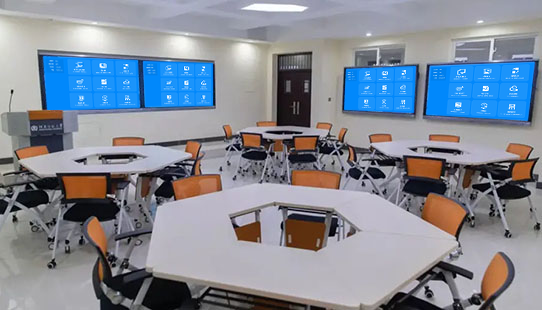Smart Classroom: An Interactive Solution for Teaching and Learning
The smart classroom solution breaks free from traditional teaching models. Through device connectivity and interactive functions, it streamlines the entire teaching and learning process—teachers face fewer disruptions during lectures, students engage more actively in classes, and efficiency is evident in every link, from in-class interactions to after-class review.
Unrestricted Device Connectivity for More Relaxed Teaching
Teachers can directly connect their smartphones, tablets, or laptops to the classroom’s main screen. With a 3-second QR code scan, they can cast courseware instantly: when walking among students during lectures, they can flip through slides with a simple swipe on their tablets; for key content, they can circle or highlight it in red directly on the device—and students even in the back row can see clearly, eliminating the need to stay tied to the podium.
Students’ tablets and laptops can also connect to the large screen effortlessly. Whenever a student wants to share their problem-solving ideas, a single tap lets them cast their draft onto the screen. During group discussions, each group’s conclusions can be displayed on the main screen in split-screen mode—no more huddling around small notebooks, making the collision of ideas more intuitive.
Innovative In-Class Interaction for More Focused Learning
Interactive activities can be launched anytime in class: when teachers pose multiple-choice questions, students select answers on their terminals, and real-time answer statistics pop up on the large screen. It becomes instantly clear which questions have high error rates and which students are falling behind, allowing teachers to provide targeted explanations afterward and avoid “one-way cramming” lectures.
Laboratory classes also become more intuitive: the document camera projects reactions in test tubes and details of parts onto the large screen, so students in the back don’t have to crowd to the front. If a student gets stuck during an experiment, they can take a photo of their operation and cast it to the screen—teachers can point to the photo and explain problems on the spot, which is more convenient than gathering everyone around.
Automated Resource Management for Effortless After-Class Review
Courseware, annotations from class, and students’ answer records are automatically saved to the class resource library. Students can scan a QR code after class to review the content, no longer worrying about missing notes. Teachers can check backend data to identify students’ weak points, making it easier to adjust teaching priorities accurately—no more relying on guesswork.
Devices are ready to use once connected to the internet. Administrators can remotely monitor the status of equipment in each classroom, eliminating the need to visit classrooms every day. With smart teaching implemented this way, not only is human resource input reduced, but the actual effectiveness of both teaching and learning is significantly improved.
